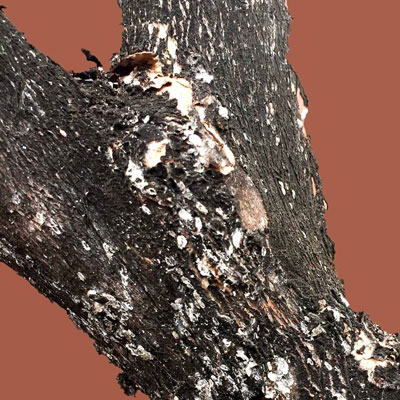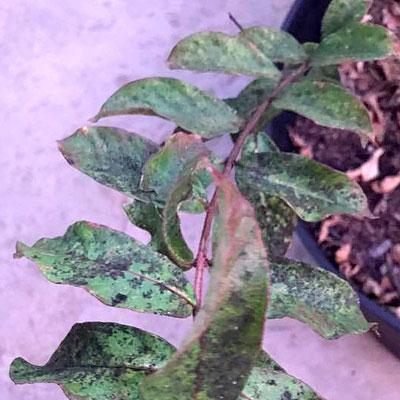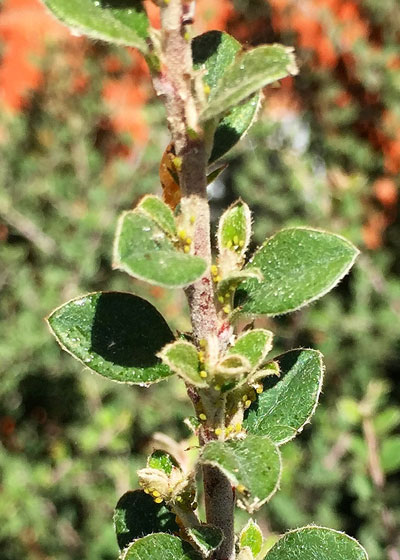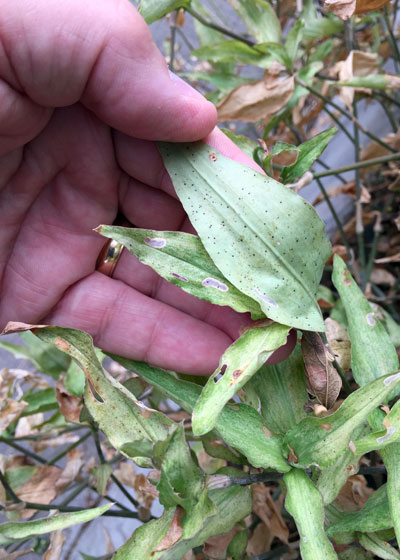Question of the Week Number 2: October 4, 2018
“What can I do to eliminate the black mold on my (insert your plant’s name here)?”
What you are seeing is a fungus called sooty mold. It’s a frequent visitor to many plant species. In fact, my first memory of the gardenias alongside our front door in College Station was of white flies all over their leaves. My second recollection was of the black sooty mold that grew all over the leaves. I was too young, however, to realize that the two things were closely related.

Sooty mold has grown in honeydew secreted by crape myrtle scale. Two things to note: (1) The scales have all been devoured by lady bugs, and (2) The sooty mold will slough off as this old bark is shed next spring.

Sooty mold growing on leaves of crape myrtle.
How sooty mold develops…
Sooty mold requires a sugary substrate. Given that “honeydew” the fungus will develop on leaves and trunks of almost any species, even on cars and boulders.
Several types of insects are known for the honeydew they secrete as they suck sap out of their host plants’ leaves. Here are some of the most common:

Aphids congregate by the hundreds on new growth of many types of plants such as this gray cotoneaster.
• Aphids. Generally pinhead-sized, these are always pear-shaped. They colonize in great numbers, usually on new growth. You’ll see the tiny “driplets” of sap falling as they feed on pecans, oaks, crape myrtles and other tall plants. They’ll also appear on shrubs, annuals and perennials.

Lacebugs leave foliage mottled tan. Their droppings are quickly noticeable on the backs of affected leaves. This is one of the dayflowers, a native relative of spiderworts, purpleheart and wandering Jew.
• Lacebugs. I’m probably just imagining things, but it seems like these pests have started attacking a much larger list of host plants in the past 25 years. Bur oaks, chinquapin oaks, Texas sage, pyracanthas, boxwoods, azaleas and Boston ivy come to mind. I’m sure there are others. You may not see the Cellophane-like adult insects, but you’ll definitely see the tan mottling they cause to the leaves as well as the black, waxy droppings they leave on the backs of the leaves.
• Whiteflies. These are tiny fly-like, pure white insects that are found on gardenias, privets, tropical hibiscus and several other cultivated plant species. They’re more annoying than harmful, but they do leave honeydew on the leaf surfaces, and it gives rise to sooty mold. They’re difficult to control once they get started, so deal with them at first evidence.
• Scales. There are many kinds of scales, but the one that most commonly results in sooty mold development is the relatively new crape myrtle scale. The insect looks like small pieces of popcorn stuck to the twigs of crape myrtles.
To control the sooty mold you need to control the honeydew…
And that’s going to mean controlling the insects that secrete it. Aphids and lacebugs are fairly easily controlled with contact insecticides applied at first signs of the pests. The same insecticides will be labeled for whiteflies, but you’ll need to be vigilant about spraying as soon as you see them and repeatedly until you eliminate them.
Crape myrtle scale is most successfully treated preventively with a systemic insecticide (Imidacloprid) applied in mid-May, before the plants come into bloom. (Here is an excellent video explaining how from our friend Dr. Mike Merchant, urban entomologist with Texas AgriLife Extension of Texas A&M.) That same treatment will also do a good job of preventing aphids.
For the record, significant research is underway to find other alternatives for controlling the scale. A group of southern ag colleges is teaming up in the effort.
